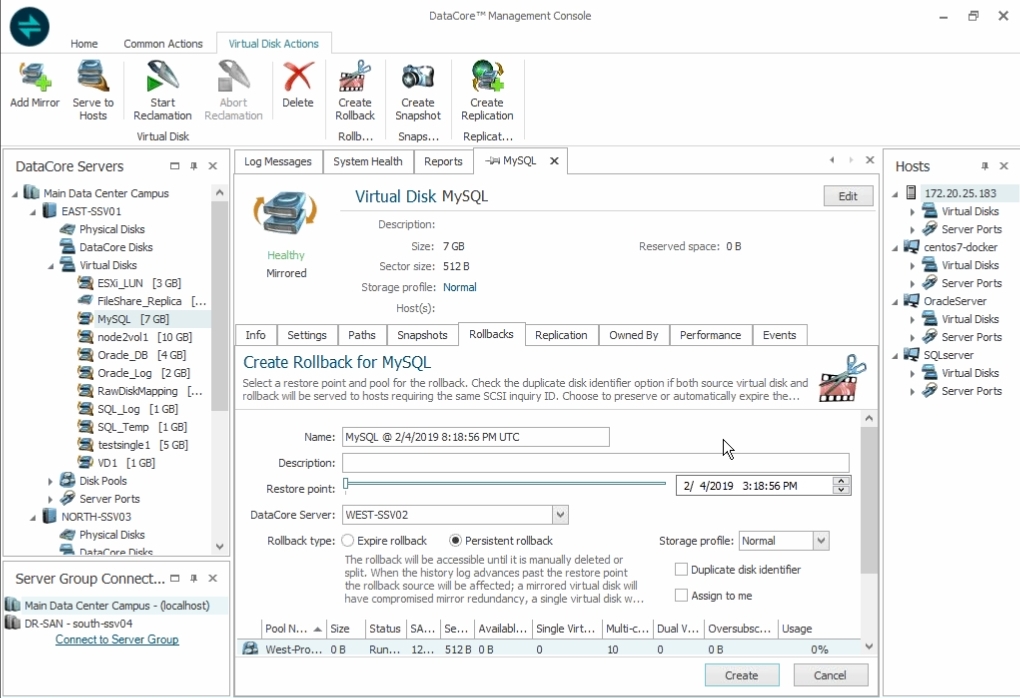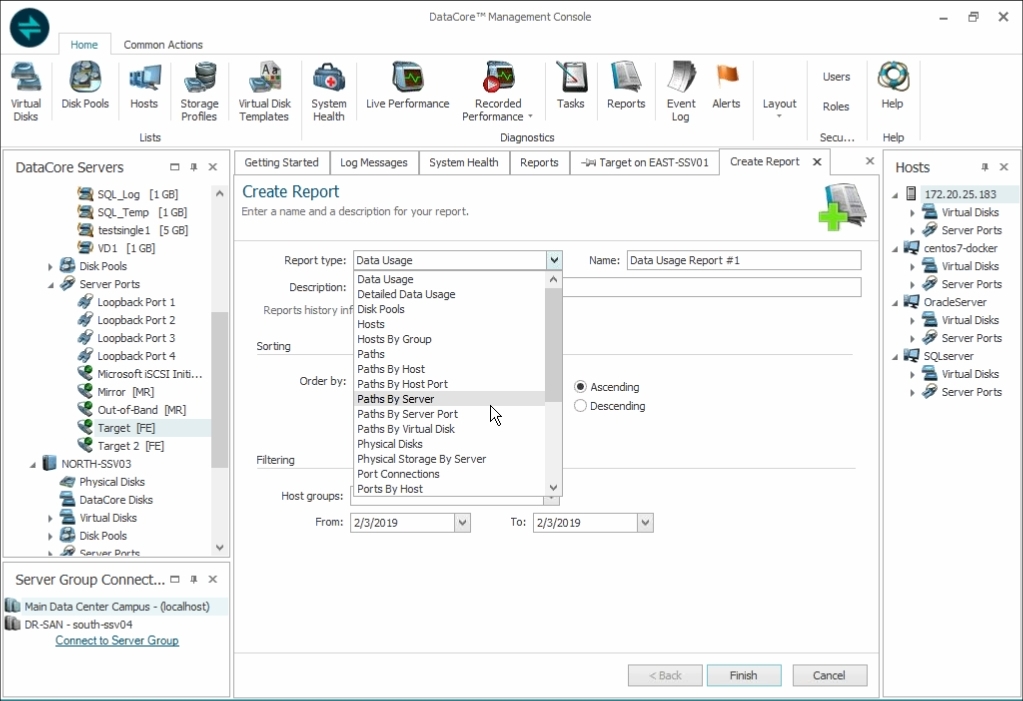Product: DataCore
Product Homepage: click here
Free Trial: click here

Enterprise storage has grown increasingly complex in recent years, three-year refresh cycles have made storage one of the biggest expenditures for IT departments, who end up with a mix of different types, vendors and generations of storage hardware. In spite of all of its potential to solve these problems, software-defined storage has often introduced additional complexity. DataCore provides a flexible SDS platform that is designed to help organizations to get a handle on their storage, while also putting an end to vendor lock-in. After hearing a lot of good things about DataCore, I decided to check it out for myself to see if their product lives up to the hype.
For those who might not be familiar with DataCore, they offer a storage virtualization product that effectively functions as a virtual SAN and provides a wide array of enterprise data services ranging from HA to storage pooling, auto-tiering, management, and boosting performance. The software includes a single pane of glass management interface that allows for a consistent management experience regardless of the underlying hardware. For example, an administrator could manage an EMC storage array, alongside an HPE storage array, without having to worry about vendor-specific nuances. This is handy for an organization that wants to avoid vendor lock. DataCore’s storage-agnostic nature can dramatically simplify storage hardware refreshes by providing an easy migration path from an aging storage array to a new one, even if it is made by a different vendor.
Review methodology
Typically when I write a software review, I like to deploy the software in my own lab. In the case of DataCore however, I did not do that. DataCore’s main strength is its ability to work with widely varying storage hardware. As such, I didn’t feel as though my lab environment was sufficient to get a good feel for DataCore’s capabilities. Since the storage hardware in my lab really isn’t all that diverse, I reached out to DataCore, and they were able to show me what their software could do in an environment that is far more diverse and complex than my own lab. In doing so, I was able to get a good feel for the software, but I did not have the opportunity to install the software myself. I, therefore, cannot give an opinion on the setup process.
DataCore’s capabilities
The DataCore architecture is based around the use of one or more DataCore x86 servers that sit in between application hosts and storage hardware. These servers allow administrators to pool together storage resources. Administrators are then able to create virtual disks on top of the pooled storage.
DataCore offers all of the capabilities that you would probably expect in a virtual SAN product. The software allows you to provision virtual disks from pooled storage. Those virtual disks can, of course, be made fault tolerant, deduplicated, and replicated. Incidentally, DataCore supports three-way replication, and you can even replicate a virtual disk to the cloud. You can see some of the replication options in the figure below.

As you look at the figure above, you will notice that several tabs are displayed for the currently selected virtual disk, and one of those tabs is labeled Snapshots. DataCore allows you to create either full or differential snapshots, depending on your needs.

One of the things that you might have noticed in the figure above, is that DataCore places Snapshots and Rollbacks on separate tabs. Rollbacks is a feature based on what DataCore called Continuous Data Protection: every write is protected for 14 days, so in the case of a problem, such as a ransomware attack, the user can instantly go back in time to before the incident. The Rollbacks tab includes a slide bar that you can use to choose the point in time that you want to roll back to. Of course, if you need more granular control of the rollback process, you can always enter an exact date and time. Snapshots make it simple to create a copy for any purpose such as for test/dev purposes.

DataCore seems to have all of the basics covered, and while the software does a good job of provisioning and managing storage, there were a few things that stood out to me as being particularly helpful. First, DataCore places a big emphasis on performance. If you look at the figure below, you can see that the software provides some really nice performance metrics. Storage performance is often the single biggest factor in determining how well a workload will run, so it’s nice that DataCore provides tools to show you how well your infrastructure is performing.

In addition to displaying performance metrics, DataCore provides advanced caching and a patented technology called parallel I/O, which eliminates critical bottlenecks in I/O processing, which is especially useful with faster hosts and faster flash arrays. Customers often see triple-digit performance gains with their existing hardware.
Auto-tiering is valuable whenever a mix of HP, EMC and IBM storage or other storage classes is used in a pool. DataCore software dynamically migrates hot/cold data across all those arrays without requiring human intervention, in a fully automated way, ensuring the applications that need most performance are always using the fastest storage, no migration required.
Another thing that I really liked about the DataCore software is its orchestration capabilities. These capabilities are tied to a monitoring and alerting engine that can run a script in response to a predefined trigger. Such a script might for example, attempt to repair a virtual disk, or perhaps evacuate storage pools from offline servers.
The reason why I liked DataCore’s orchestration engine so much, is because it is based on PowerShell. DataCore has created hundreds of custom PowerShell cmdlets that can be used to automate all manner of storage tasks. While you can certainly use these cmdlets to build your own scripts, DataCore has already created 28 scripts that can handle the more common tasks.


One more feature that I really liked was DataCore’s reporting engine. As you would probably expect, the software gives you the tools to generate a wide variety of reports. You can see a small selection of the available reports in the figure below.

The that I really liked about the reporting engine, however, was that DataCore will let you export reports in nine different formats. You can create reports as PDF files, spreadsheets, images, and more.

Licensing
DataCore licenses its products based on the number of terabytes of storage that are being managed. Licensed capacity can be deployed in any combination of nodes: virtual SAN, bare-metal, Hyperconverged, synchronous mirrors, or asynchronous replicas. DataCore licenses are perpetual with maintenance that is offered in 1, 3, and five-year increments.
The verdict
When I review a product for this site, I usually end the review by rating the product on a scale of between zero and five stars, with five stars being a perfect score. With that said, I decided to give DataCore a score of 4.7 stars, which is a gold star award.
The evaluation process involved testing the vast majority of DataCore’s features. During those tests, the software did exactly what it was supposed to do. I did not experience any bugs, nor were there any noticeable performance issues. The interface was fast, fluid, and responsive.
My one minor complaint about DataCore is that the interface is a little bit busy, and initially seemed somewhat overwhelming. Upon closer inspection, I quickly realized that everything is laid out in a logical manner and that the interface is actually quite intuitive. Even so, if DataCore could find a way to make the interface a little bit cleaner, I think it would go a long way toward making the product even better than it already is. The DataCore team told me they are working on an improved UI.
My overall assessment is that while DataCore’s feature set might appear to be very similar to most of the other software-defined storage products on the market, the fact that DataCore is truly hardware agnostic makes it worthy of consideration. With DataCore, you will never have to worry about storage vendor lock. DataCore also makes it easy to cope with the challenges associated with managing a mesh of cloud and on-premises storage.
TechGenix.com Rating 4.7/5





What do you think about using datacore in 2 ESXi hosts (With vcenter) with their local used by the 2 datacore VMs to manage the virtual pool (mirrored between the 2 hosts) for running production VMs?